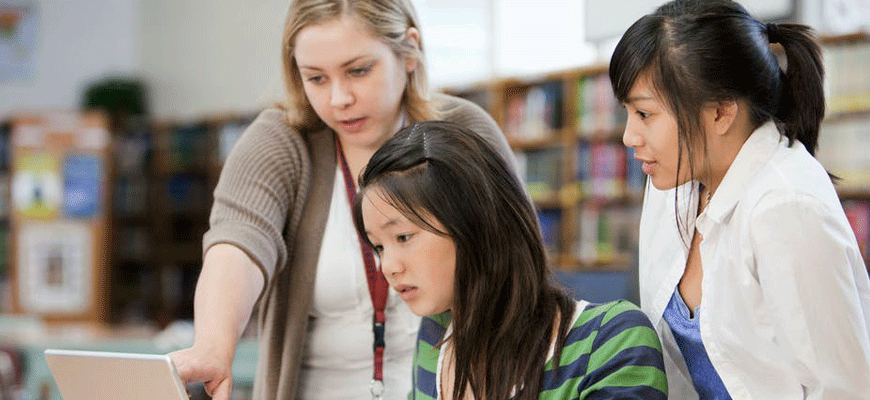
Librarians help students navigate an age of misinformation – but schools are cutting their numbers
Posted on: November 15, 2021; Updated on: November 15, 2021
By Karen Gavigan, kgavigan@mailbox.sc.edu
The number of school librarians in the United States has dropped about 20 percent over the past decade, and research shows access to school librarians has become a major educational equity issue. Karen Gavigan, information science professor, writes for The Conversation about the impact school librarians have on student achievement.
School librarians hear the question all the time: Why do we need school libraries and school librarians when students have the internet?
The perception is that a computer and Wi-Fi are all students need for their informational and recreational needs.
Meanwhile, the number of school librarians in the U.S. has dropped about 20% over the past decade, according to a July 2021 study funded by the Institute of Museum and Library Services. Many states, including Arizona, Texas and Pennsylvania, do not fund or mandate school librarian positions. And an analysis from the National Center for Education Statistics revealed that Hispanic, nonwhite and nonnative English speakers are the students most affected by the decline in librarian positions.
“Access to school librarians has become a major educational equity issue,” says Keith Curry Lance, who with Debra Kachel led the IMLS study. In a recent email he told me, “School districts losing librarians tend to be ones that can least afford the loss in a society characterized by increasing economic inequality.”
As a former school librarian who researches school library issues and trains future school librarians, I know that decades of research demonstrate that K-12 school librarians have a significant impact on student achievement.
Here are four functions that school librarians carry out that I believe make their role more important now than ever.
1. Foster digital literacy
As bestselling author Neil Gaiman put it, “Google can bring you back 100,000 answers. A librarian can bring you back the right one.”
Recently, there has been an alarming rise in misinformation and disinformation. This is bad news for democracy. A 2016 Stanford University study found that nearly 80% of high school students struggle to verify the credibility of a source.
A 2012 Pew Research study revealed that 83% of K-12 teachers think the amount of information available online today is “overwhelming for most students.” Over 70% believe that today’s digital technologies “discourage students from finding and using a wide range of sources for their research.”
School librarians are information literacy experts trained to teach students how to access and navigate the tsunami of digital information available to them, and how to determine the authenticity of that information.
2. Champion the joy of reading
School librarians collect and curate high-quality print and digital materials that help students develop a lifelong love of reading. Take, for example, Tamara Cox, librarian at Wren High School in Piedmont, South Carolina, and winner of the American Library Association’s I Love My Librarian Award in 2018. Cox partnered with the county election commission to bring in voting machines for a book award contest to creatively encourage both reading and civic education.
Findings from studies such as the 2014 South Carolina Association of School Librarians’ impact study affirm that students who attend schools with full-time certified school librarians score higher on standardized reading tests.
3. Help teachers enhance their lessons
School librarians collaborate with classroom teachers to locate resources that enhance and support authentic classroom instruction. For example, Cindy Symonds, the librarian at Round Top Elementary School in Blythewood, South Carolina, collaborated with fourth-grade teachers to have students use databases to research a historic weather event, such as Hurricane Katrina in 2005 or the Joplin Tornado in 2011. Then, with the help of a technology instructor, the students filmed themselves using a green screen to create a weather report.
School librarians also work to ensure that students are taught issues of intellectual freedom. They collaborate with teachers to help students understand the ethical use of ideas and information. These include lessons about acknowledging authorship, properly citing content and developing an understanding of how to correctly use and reproduce others’ work.
4. Seek out creative, diverse materials
School librarians select inclusive materials that represent diverse points of views. This ensures that students have materials that reflect their own experiences as well as the experiences of others.
Librarians often provide innovative and creative programs that promote active learning spaces where students share ideas, equipment and knowledge while they work on projects. For example, during Hispanic Heritage month, the students at James Simons Montessori School in Charleston, South Carolina, read books by Latino authors and researched the authors’ countries of origin. They also made artifacts, such as national flags and maps with landmarks and used Makey Makey invention kits to code and present their facts on interactive displays. The project combined research, literacy, coding, circuitry, self-expression and creativity.
Rosie Herold, who oversaw the project, says observers might be “taken aback by my library’s apparent disorder, the lack of desks, the constant movement of students, cardboard everywhere, the constant chatter and the energy level.”
“But,” Herold adds, “spend more than a cursory look, more than a quick investigation
and you will find the future of education.”![]()
This article is republished from The Conversation under a Creative Commons license. Read the original article.
Banner Image photo credit: Nearly 80% of high school students struggle to verify the credibility of a source, a 2016 study found. Hill Street Studios/DigitalVision Collection via Getty Images